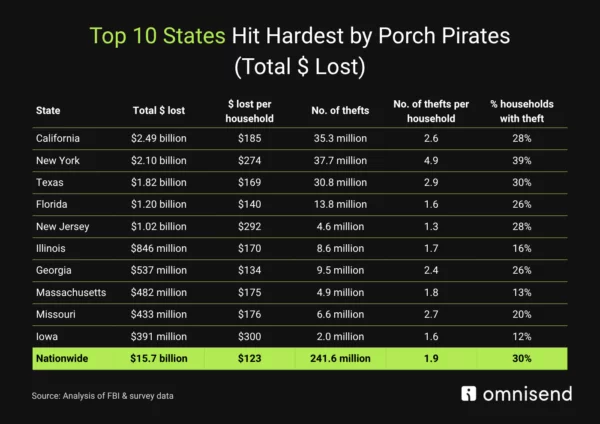New research from Omnisend, combining FBI crime data with a consumer survey, found that Americans lost an estimated $15.7 billion from 241 million stolen packages in 2024.
Most stolen packages aren’t high-value on their own – the average loss is $65 per package, and 85% are under $100, but the volume of thefts makes the totals add up fast. On the delivery side, stolen packages were reported most frequently from Amazon (72%), followed by UPS (31%), FedEx (30%) and USPS (29%).
When packages go missing, retailers are usually the ones left paying. Around 70% of victims received a refund or replacement, and stolen-item refunds alone are estimated at $6.5 billion. Others were offered discounts or store credit (23%), while nearly a quarter (23%) said the retailer refused responsibility.
That experience shapes how consumers shop going forward:
- 44% say they now order online less often
- 27% shift some purchases to lockers or in-store pickup
- 29% buy only from retailers with easy refund policies
“Retailers can’t eliminate package theft, but they can minimize future losses by building trust – offering clear refund policies, flexible delivery options, and customer support that reassures shoppers they won’t be left on the hook. With Americans already planning to reduce their holiday spending, retailers are particularly vulnerable to theft losses this year,” says Marty Bauer, Ecommerce Expert at Omnisend.
New York and Hawaii Hit Hard
Three in ten households reported being hit in the past year, but the risk wasn’t spread evenly. States like New York (39%) and Hawaii (38%) saw some of the highest share of affected households, while Alabama (5%) and Kentucky (8%) reported the lowest rates.
The frequency of theft also varied dramatically. Nationwide, households averaged 1.9 stolen packages, but in New York (4.9) and Wisconsin (4.6) the problem was more severe. By contrast, states like Oklahoma (0.2) and Maine (0.3) experienced the smallest levels of repeat theft.

“Package theft depends a lot on where you live. In dense states like New York, which dominates our ranking across metrics, repeat theft is far more common because of dense living areas and crowded mailrooms. Meanwhile, in places with more space and tighter-knit neighborhoods, such as Oklahoma, it happens considerably less often. For consumers, that means the risk isn’t just about what you buy online, but also where you live and how the packages are delivered,” says Bauer.
Methodology
Omnisend blended FBI state‑level “other larceny” incidents at residences with a nationally representative survey of 1,067 U.S. adults. FBI totals were scaled for non‑reporting agencies and adjusted using survey‑measured reporting rates to account for unreported thefts. Monetary values were assigned from the survey‑reported loss amounts. Omnisend also calculated totals directly from the survey. Final national estimates combine both sources via a weighted average (survey 75%, FBI 25%), providing a fuller view of where theft occurs, how often it happens, and what it costs consumers and retailers.
More info: https://www.omnisend.com/blog/package-theft-in-america/

 OFFER
OFFER










